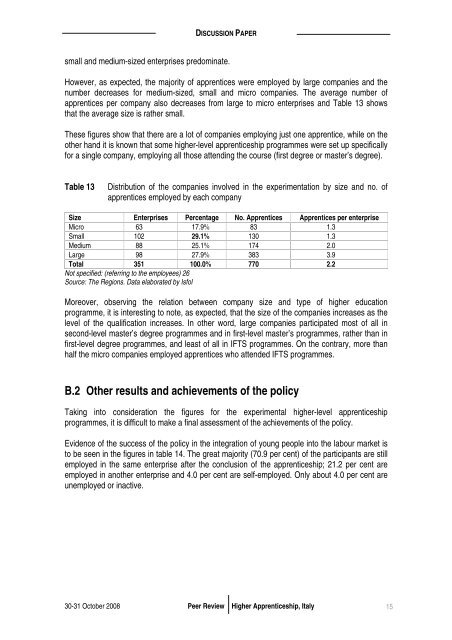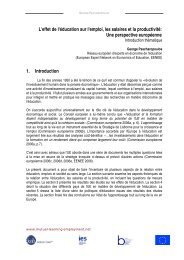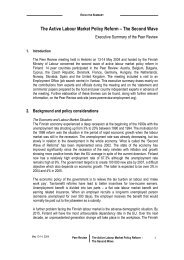Discussion Paper - Mutual Learning Programme
Discussion Paper - Mutual Learning Programme
Discussion Paper - Mutual Learning Programme
You also want an ePaper? Increase the reach of your titles
YUMPU automatically turns print PDFs into web optimized ePapers that Google loves.
DISCUSSION PAPER<br />
small and medium-sized enterprises predominate.<br />
However, as expected, the majority of apprentices were employed by large companies and the<br />
number decreases for medium-sized, small and micro companies. The average number of<br />
apprentices per company also decreases from large to micro enterprises and Table 13 shows<br />
that the average size is rather small.<br />
These figures show that there are a lot of companies employing just one apprentice, while on the<br />
other hand it is known that some higher-level apprenticeship programmes were set up specifically<br />
for a single company, employing all those attending the course (first degree or master’s degree).<br />
Table 13 Distribution of the companies involved in the experimentation by size and no. of<br />
apprentices employed by each company<br />
Size Enterprises Percentage No. Apprentices Apprentices per enterprise<br />
Micro 63 17.9% 83 1.3<br />
Small 102 29.1% 130 1.3<br />
Medium 88 25.1% 174 2.0<br />
Large 98 27.9% 383 3.9<br />
Total 351 100.0% 770 2.2<br />
Not specified: (referring to the employees) 26<br />
Source: The Regions. Data elaborated by Isfol<br />
Moreover, observing the relation between company size and type of higher education<br />
programme, it is interesting to note, as expected, that the size of the companies increases as the<br />
level of the qualification increases. In other word, large companies participated most of all in<br />
second-level master’s degree programmes and in first-level master’s programmes, rather than in<br />
first-level degree programmes, and least of all in IFTS programmes. On the contrary, more than<br />
half the micro companies employed apprentices who attended IFTS programmes.<br />
B.2 Other results and achievements of the policy<br />
Taking into consideration the figures for the experimental higher-level apprenticeship<br />
programmes, it is difficult to make a final assessment of the achievements of the policy.<br />
Evidence of the success of the policy in the integration of young people into the labour market is<br />
to be seen in the figures in table 14. The great majority (70.9 per cent) of the participants are still<br />
employed in the same enterprise after the conclusion of the apprenticeship; 21.2 per cent are<br />
employed in another enterprise and 4.0 per cent are self-employed. Only about 4.0 per cent are<br />
unemployed or inactive.<br />
30-31 October 2008 Peer Review Higher Apprenticeship, Italy<br />
15





